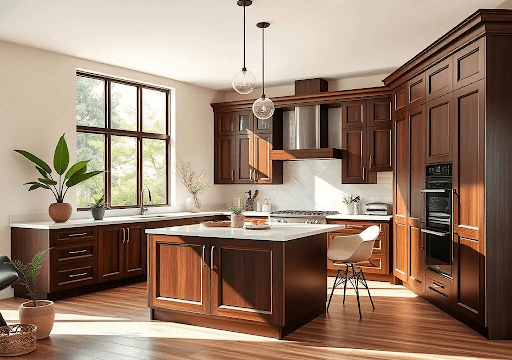There’s a small satisfaction in building something with your own hands. Ready-to-assemble cabinets, known as RTA, turn that impulse into part of the remodeling process. What arrives as a stack of panels and hardware soon becomes a working kitchen, assembled one hinge and drawer at a time.
The idea has outgrown its budget beginnings; today’s versions are engineered with careful precision—solid wood fronts, clean joinery, and finish options that rival custom work. Each step in the build reveals the structure behind the beauty, the practical bones of the kitchen itself.
What Makes RTA Cabinets Unique
RTA cabinetry sits at the meeting point between modern manufacturing and old-fashioned handcraft. Each component is designed to fit perfectly with the next, yet the assembly still feels personal.
In Canada, Morsun has refined this concept, offering ready-to-assemble kitchen cabinets that combine clear design with dependable materials. These systems allow homeowners to shape their kitchens piece by piece, creating a space that feels both precise and approachable—something built, not merely installed.
Hidden and Innovative Storage Spaces
The best RTA systems reward curiosity. Open a door and there’s a sliding rack for sauces. Pull a drawer, and a shallow tray glides forward to reveal spices, lids, or utensils. Corners that were once awkward become small rotating shelves.
Even the narrow space beside the stove can turn into storage for baking sheets or cutting boards. Every surface has a potential use, and every inch is engineered to hold more than it seems. A well-designed RTA setup makes you rethink what a kitchen cabinet can hide.
Modular and Customizable Design
Each cabinet is a module—a building block that can be rearranged as the kitchen demands. The sizes are standardized, yet the combinations feel limitless. Tall pantry towers rise beside ovens; smaller wall boxes bridge over fridges or windows.
Open shelving breaks up solid runs of doors, while filler strips close gaps that older homes often leave behind. The system works like a carpenter’s puzzle: add, remove, reconfigure. When damage occurs or tastes shift, a single section can be swapped out without dismantling the entire room.
Affordability Without Compromising Quality
The reason RTA cabinets remain accessible comes down to logistics. By shipping panels flat, manufacturers cut transport and storage costs. The savings fall to the buyer, but the craftsmanship stays intact. Plywood boxes, solid fronts, dovetailed drawers, and soft-close slides are now standard across reputable makers.
Instead of trimming quality, the system trims excess handling. For anyone willing to assemble, the result is sturdy cabinetry that feels built to last, not mass-produced. In Canada, Morsun offers RTA collections designed with this same principle—simplicity that doesn’t sacrifice substance.
Eco-Friendly Materials
Cabinet production has grown more mindful in recent years. Many RTA manufacturers use wood from managed forests and finishes that limit chemical emissions indoors. Bamboo, reclaimed fiberboard, and fast-growing hardwoods reduce strain on natural resources.
Even the packaging reflects a shift toward efficiency: less air space, smaller shipping volume, lighter freight. Choosing this format isn’t just practical—it’s a quiet step toward kitchens that respect both material and environment.
Easy Assembly for DIY Enthusiasts
Assembly has become part of the ritual. Panels arrive labeled and pre-drilled, the holes clean and precise. Cam locks snap into place with a click; drawers slide in with measured resistance. A cordless drill, a level, and some patience are usually enough.
What might once have seemed daunting now feels almost meditative. There’s a certain rhythm to it—the slow alignment of edges, the first swing of a mounted door—that connects the homeowner to the finished result.
Adaptable Styles and Finishes
The catalog of RTA cabinetry reads like a cross-section of design history. You can find flat-panel doors that speak to mid-century restraint, shaker frames that echo farmhouse traditions, or minimalist, handle-free options suited to modern apartments.
Color choices stretch from pale birch to charcoal and deep indigo. Textured laminates mimic brushed oak or hand-finished walnut without the upkeep. These options let a kitchen reflect its owner’s taste without crossing into extravagance.
Smart Use of Space in Small Kitchens
Tight kitchens often test a cabinetmaker’s patience. RTA components meet that challenge with precision. Slim pull-outs occupy leftover inches between appliances; corner carousels reclaim unreachable depths. Shallow drawers near the cooktop hold utensils without crowding, while vertical tray dividers keep pans upright.
Even the toe-kick—the space most people ignore—can hide a drawer for trays or linens. Planning software now allows homeowners to visualize these choices before ordering, reducing mistakes and making every square inch count.
How RTA Cabinets Are Changing the Way We Renovate Kitchens
The way we renovate has shifted. What used to depend on long lead times and heavy custom work now leans toward systems people can build themselves.
RTA cabinets have quietly changed how kitchens take shape: homeowners become part of the process rather than distant clients waiting for delivery. Each panel and hinge reveals how design, carpentry, and personal labor overlap.
Here’s how RTA cabinetry has redefined the renovation process:
- Shorter timelines: Flat-packed units can arrive within days instead of weeks.
- Hands-on installation: Homeowners learn practical joinery while assembling.
- Reduced waste: Components are pre-measured, cutting down on offcuts and unused wood.
- Adaptable layouts: Cabinets can be rearranged later as needs or appliances change.
- Lower labor costs: Much of the installation is done independently, saving on contractor hours.
| Renovation Factor | Traditional Custom Cabinets | RTA Cabinets |
| Delivery Time | 6–10 weeks | 1–3 weeks |
| Assembly | Done by manufacturer | Done by homeowner |
| Adjustability | Limited once installed | High—components can be reconfigured |
| Cost Range (approx.) | $$$$ | $$ |
| Typical Materials | Plywood or MDF | Plywood, MDF, or hybrid |
| Waste Generated | Moderate to high | Low due to pre-cut precision |
How RTA Cabinets Transform Your Kitchen into a Space of Discovery
Every door, hinge, and drawer becomes an invitation to explore. RTA cabinets reveal the structure that most kitchens hide—the meeting points, the fasteners, the joinery that holds everything upright. During assembly, you learn the anatomy of the space you use most. It’s not only functional; it’s quietly instructive.
The finished kitchen often reflects that learning. Pull-out drawers hold utensils in reach; corner carousels move with a light touch; soft-close hardware muffles the evening’s last dish. The small surprises that come from building your own storage—such as under-sink trays, double-decker drawers, and vertical knife racks—turn the room into something that rewards curiosity. What began as a kit becomes a record of problem-solving and persistence.
Final Thoughts
RTA cabinets have outgrown their reputation as a low-cost substitute. They now represent a shift in how people think about making a home—where design isn’t purchased whole but assembled, considered, and understood. For many, it’s the first time they’ve tightened a hinge and felt the cabinet align, the first time they’ve built the thing they use every day.
It’s practical, yes, but also personal. The act of building changes how you inhabit the kitchen afterward. Each drawer that opens smoothly carries a memory of the day it was installed, each shelf a reminder of the patience it took. In a world where most furniture arrives finished, RTA cabinetry offers something unusual: a kitchen that tells its story from the inside out.





























